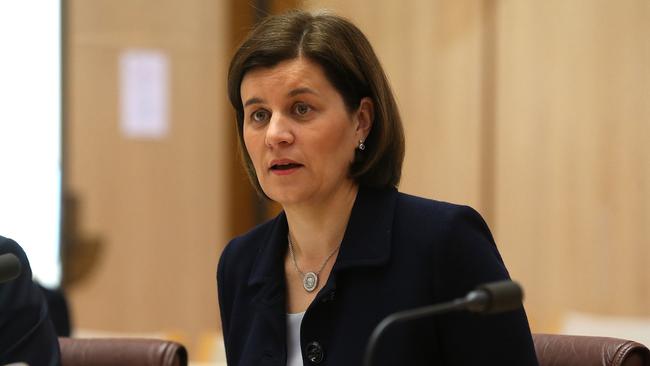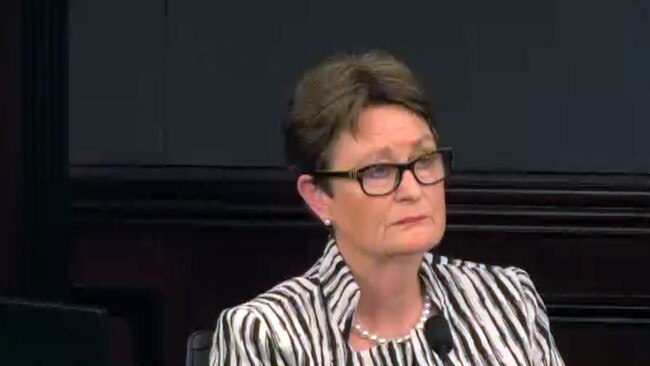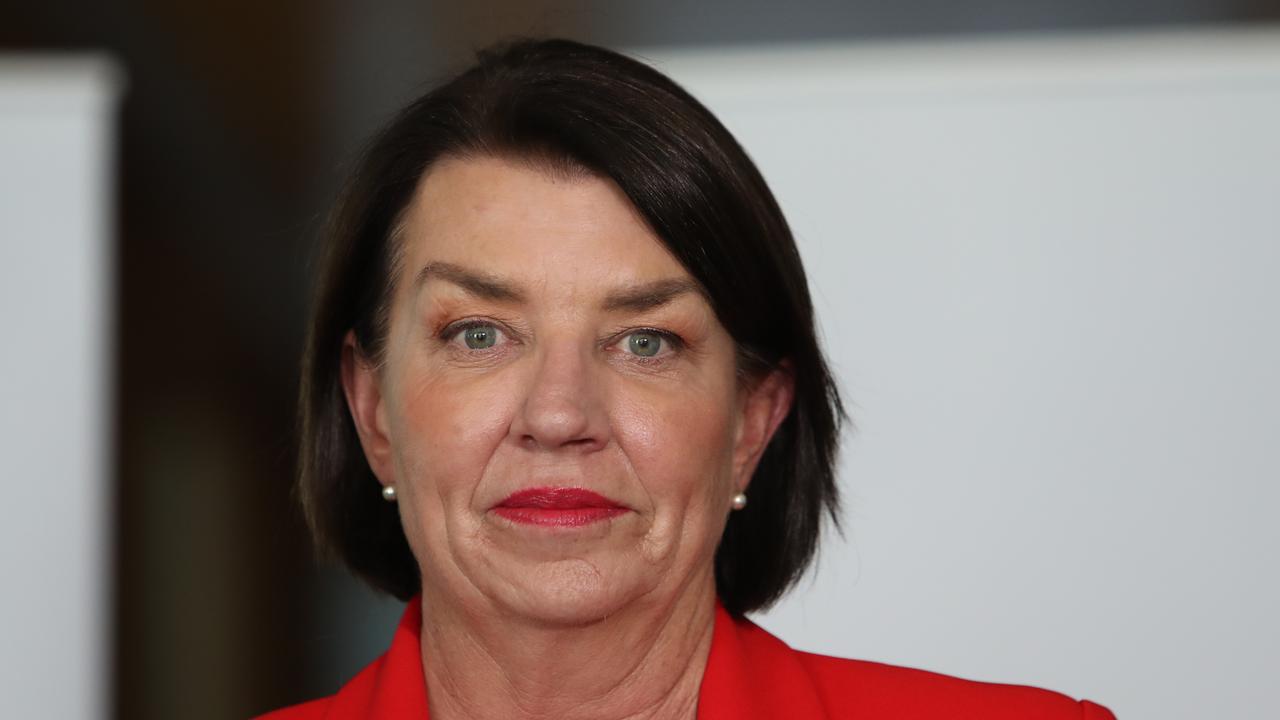Banking royal commission: Round 7 — policy and CEOs - Catherine Livingstone and Brian Hartzer
Some Westpac customers will have waited 11 years to be compensated after being charged for advice they never received.
Welcome to our live coverage of the seventh round of the Royal Commission into Misconduct in the Banking, Superannuation and Financial Services Industry, this week being held in Sydney.
Senior counsel assisting the royal commission Rowena Orr QC is questioning CBA chair Catherine Livingstone over governance at the bank.
After questioning Ms Livingstone on the apparent inadequacy of the board’s processes, Ms Orr embarked on an extensive set of questions about the way executive bonuses were approved by the board.
Despite the exhaustive reporting of CBA’s failings over recent years, this morning’s hearing still managed to produce some startling revelations, including:
- Former chairman David Turner refused a request from the board to repay 40 per cent of his last annual director’s fee in atonement for the bank’s many scandals.
- Former CEO Ian Narev recommended that all his direct reports receive the full bonus they could achieve on risk metrics. Meanwhile chief risk officer David Cohen also told the remuneration committee there were no risk-related reasons the executives shouldn’t get their full potential payments.
- Counsel assisting Rowena Orr QC said CBA may have breached the Corporations Act by failing to keep adequate minutes of board meetings.
- The minutes of the board meetings in question did not support Ms Livingstone’s claims that she had challenged executives over various issues.
- Despite a global search, CBA found it “almost impossible” to find a new CEO that had not been touched by some kind of “regulatory event”.
- Ms Livingstone named former CBA wealth management chief Annabel Spring and former CIO David Whiteing, as executives who, with hindsight, should have forfeited their entire bonuses.
- Ms Livingstone conceded that action on bonuses only occurred after adverse media coverage.
Westpac’s CEO Brian Hartzer is answering senior counsel assisting the commission Michael Hodge QC’s questions this afternoon.
6.04pm: Customers’ 11-year wait
Some Westpac customers will have waited 11 years to be compensated after being charged for advice they never received.
Westpac has so far paid $10.75 million to 6657 customers charged fees for no service by financial advisers it employed.
But it expects to pay another $106 million to a further 25,000 customers by April 2019.
Westpac CEO Brian Hartzer agreed that meant some customers will end up getting refunds for fees they were charged as long as 11 years ago.
The banking royal commission heard Westpac initially thought the fees-for-no- service issue was limited to a small number of problem advisers. Mr Hartzer said Westpac now accepts that belief was wrong.
Compensation for fees-for-no-service issues across the banking and wider financial services industry is expected to top $1 billion.
Westpac is still working out how much compensation may be required for customers charged ongoing advice fees by authorised representatives, as distinct from its salaried advisers, without getting the service.
The royal commission heard Westpac and others have told regulator ASIC that some sort of industry solution is required.
“I don’t know that we were the first ones to make that suggestion,” Mr Hartzer said today.
“I think that has been generally recognised.” He said the solution was still being worked through but would involve a common methodology for contacting customers and the information that was required for remediation, as well as what to do when the customer or adviser could not be contacted.
AAP
4.29pm: Westpac ‘not yet provisioned for problem fees’
On the fees for no service scandal, senior counsel assisting the commission Michael Hodge QC acknowledges that the bank had initially thought the issue was limited to a small number of problem advisers.
Mr Hodge highlights the total amount provisioned in relation to its advisers is in the realm of $117 million with $10.75 million handed out so far.
Westpac CEO Brian Hartzer says he expects the remediation for its employed financial advisers by April of 2019; three years after Westpac first learned of the issues about fees for no service.
He says Westpac’s own customer management and billing systems have contributed to the problem, adding to the time it takes to remediate customers.
Mr Hodge points out that Westpac has not yet provisioned for the problem fees attributable to the authorised representatives of its dealer groups,
The bank estimates the figure involved is about $991 million in ongoing advice fees between 2008 and 2018.
We hear that Westpac pays remidiation to clients of its own advisers if it can’t prove that advice was provided. But that’s not the case for clients of its licensees.
Mr Hartzer says the different contractual arrangements, record keeping accuracy, incomplete records and access to information have provided challenges to settling those fees.
“And so then that leads to the problem which is if you were to simply adopt the same approach for your employed financial advisers and carry that over to the authorised representatives, the amount of remediation that would need to be made could be very, very, very significant.” Mr Hodge puts it to him.
“It’s not quite that simple,” Mr Hartzer says.
“If you thought that there was only $10 million of fees that had been taken by those authorised representatives over the period of 10 years, you wouldn’t be going through this level of agony to decide whether to remediate or not” Mr Hodge puts it.
“Possibly. I accept that that could be a part contributor, but we still have to get hold of the files on the customers and have a basis for making a payment rather than just using no data at all,” Mr Hartzer says.
“However much that is, it’s beyond what has been provisioned by Westpac already?” he asks.
“Well in that we haven’t provided for that,” Mr Hartzer answers.
“When you think about the fact that you have these authorised representatives operating under your licences where you don’t know what they contracted to provide, you don’t know who they contracted to provide it to and you don’t know whether it was provided, does that tell you anything about whether you were ever really very interested in providing high quality advice?” Mr Hodge says.
“I don’t think the suggestion that you seem to be making follows directly,” says Mr Hartzer.
Westpac is said to have had a total of 1046 practices operating under its licence during the period 2009 to 2015. It’s a figure Mr Hartzer says he is not familiar with but will accept.
4.13pm: A perceived conflict of interest
Mr Hartzer says the economics of operating a large scale financial advice business with high quality and highly compliant advice are getting very difficult.
“Advice is inherently a challenging issue to monitor because you’re talking about a subjective conversation between two people at some point. Investing inevitably has a level of subjectivity around it which can mean that, with the best will in the world, results don’t necessarily come out the way you expect them to.”
He says the standard of documentation and proof expected of the industry is now higher, but that is adding costs for training, audit, “hindsighting” and storing documents.
Mr Hodge asks whether authorised representatives were seen as a distribution network for Westpac’s wealth products, and whether Westpac was seeking out an efficiency benefit by having both the manufacturer and licensee of BT products.
Mr Hartzer says the decision to sell BTIM instead of implement regulatory controls was not only down to cost but to manage a perceived conflict of interest.
3.58pm: Westpac’s grandfathered commissions
Westpac’s BT wealth advice business takes the spotlight now. Its current customer remediation bill for inappropriate advice is sitting at $47 million, we hear.
Mr Hartzer confirms the level of risk that BT is exposed to, due to its processes and conduct, is currently outside of its risk appetite. Something that he says has been the case for “a while now”.
Mr Hodge points out a report from the risk review committee which states that “it is not inappropriate for these risks to continue to be risk-accepted”.
Mr Hartzer says extra controls minimise the impact of one of those risks manifesting.
Mr Hodge asks why Westpac didn’t turn off grandfathered commissions in 2013.
“Well it was part of transitional arrangements that those advisers had as part of their revenue, these previous arrangements and so we thought that that would naturally flow off in the same way that it would across the industry.”
“But you’ve now changed how they’re paid?.. Is there some reason why you couldn’t change how they were paid in 2013?”
“I don’t know”.
3.43pm: Customers’ best interests not necessarily everyone’s

Mr Hodge questions Mr Hartzer on the move to give up flex commissions, which would effectively lose its auto finance business.
Mr Hartzer says a move made “unilaterally” would not change the outcomes for customers and that a more constructive way to deal with it was to advocate with ASIC for it to stop.
Mr Hodge points out Westpac’s prescribed lack of appetite for conduct risk, but that the application of that depends on particular judgements made within the business.
He tenders a round 1 submission made in relation to auto finance, in which the bank notes any changes to the “point of sale exemption” would represent a major shift to the industry but that any consideration should take into account the impact to all stakeholders.
“So Westpac’s position is although this might benefit customers... it doesn’t necessarily follow that there should be the change?” Mr Hodge asks.
“Right.”
3.30pm: Car loans
The questioning turns to Westpac’s car loan business and a case study tendered to an earlier hearing.
Mr Hartzer says it was a mistake.
“And have you considered whether there might be cultural factors that contributed to the conduct?” Mr Hodge presses.
“We’ve considered it but its not obvious that’s an issue here.”
He considers that a possible explanation is “from reading the story, it was a very sad story of a woman who was really desperate to get a car, and he may have been just really trying to get her a car”.
Mr Hodge acknowledges Mr Hartzers experience in finance - then asks in his experience whether a choice between profit and commissions and fraud to Westpac “out of the goodness of the dealer’s heart” is more likely.
“I couldn’t say, I’m not a car dealer,” Mr Hartzer replies.
Mr Hodge characterises that reply as flippant.
3.14pm: A difference of opinion
Mr Hartzer agrees that “when it comes to matters of things like the application of the responsible lending obligations, there can be differences of opinion as to how the law applies”.
He says the changes the bank has made do not relate to appetite for risk but the way in which compliance risk is managed.
But he maintains the bank and the regulator can have genuine disagreements.
“Sometimes they might form a view. We might have other facts that they’re not aware of. The proper process is to engage, to share views, explain our rationale, let them consider it.
“But if after that process we still don’t agree, then overwhelmingly we would default to their view.”
3.00pm: Remuneration and expectations
Mr Hartzer says the issue of the credit limit increases (CLI) was struck out as a “learning” about processes and not a specific error by any individual. — Thus no remuneration consequences as a result of the issue.
He says the bank’s broader systems and culture were the primary causes of the misconduct.
“Does that seem problematic to you, if you want to change the culture of the bank, don’t you need to apply remuneration consequences to employees who act in a way that you don’t want them to act?” Mr Hodge asks.
“Yes. Although I think we also have an obligation on ourselves as a company to make expectations very clear upfront, and I think that’s part of the issue here.”
Mr Hartzer says had the case happened today, there would be remuneration consequences because “expectations are much clearer”.
2.48pm: Responding to ASIC
Asking about Mr Hartzers “second line of defence” - which includes the establishment of a dedicated regulatory governance and assurance function - Mr Hodge asks how the situation would be different now.
“They would be directly speaking with the regulators. They might frequently co-ordinate meetings between the business leaders and regulators themselves, which is something we’re doing a lot more of so that feedback goes direct,” Mr Hartzer answers.
They then turn to expansion of management reporting of regulatory matters.
Mr Hartzer admits there was no dedicated regulatory reporting in place in 2012. That function was housed within risk reporting and that the bank has added regulation as a separate agenda item at its risk committees.
Mr Hodge points to the fact that every other bank changed its processes on receipt of the ABA letter, but that Westpac did not.
Mr Hartzer tells Mr Hodge he hasn’t looked into why nobody at a more senior level had stepped in.
“Your belief is things have changed enough now within your bank that it would be understood that there is an issue with going directly against the view that ASIC has expressed about the law?”
“Absolutely”
“But at the time, for whatever reason, that wasn’t the case?”
“Yes”.
2.36pm: More respect for the regulator’s view
Mr Hodge asks about a Westpac steering committee that the ASIC credit card issue was brought to in 2013.
Mr Hartzer says those in the group would not have the level of seniority the bank would require to deal with a disagreement with the regulator today.
He says that in hindsight, the managers and executives of Westpac should have shown a greater degree of respect for the view of the regulator and expected that they only act in opposition to those views if they had sign-off from lawyers and senior executives.
“I think there was clearly a deficiency in understanding the seriousness with which regulatory disagreements needed to be dealt with,” he says.
“There needed to be clearer ownership within the first line business management for the fact that they were accountable for making sure they met their compliance requirements.”
Mr Hodge reminds Mr Hartzer of Westpac’s credit general manager David Malcolm’s evidence during round one of the commission, in which he accepted that the bank continued with the credit limit increase process to obtain profits - estimated at $23 million - from the program.
He pushes the CEO as to whether he accepts, even now, that ASIC’s view was right.
Mr Hartzer says it’s moot because credit limit increase offers have ceased altogether.
2.23pm: Westpac was an ‘outlier’

Mr Hodge is probing ASIC’s intervention in credit card limit increase practices over responsbile lending concerns, dating back to 2012, and whether it is a problem that Westpac’s risk function’s views on the issue were overridden by its product team.
Mr Hodge says ASIC regarded Westpac an outlier compared to the other banks on the issue, due to the position taken by the bank’s risk function. By this time, all the other major banks had ceased the practice.
Mr Hartzer says being regarded as an outlier doesn’t per se show any issues with the bank’s risk function.
“We don’t have to agree with all the other banks all the time.”
“Or the regulator?” Mr Hodge asks
“No, with the regulator we need to work it through and that, in my mind, is where we went wrong with this one.”
“We should have been proactive in going to ASIC, talking about the differences, seeing if we could resolve them, explaining why we thought our position was correct and in this case, if ASIC had been firm in its views, we should have in my view, acquiesced.”
Mr Hodge says this would have essentially been testing ASIC’s resolve on the matter.
Mr Hartzer agrees with his contention.
2.05pm: Westpac CEO Brian Hartzer appears
After this morning’s extraordinary session with CBA chair Catherine Livingstone, Westpac CEO Brian Hartzer has been sworn in.
Mr Hodge begins by asking him questions about credit card credit limit increases.
1.03pm: Staying on track
Ms Orr asks how we can be confident that CBA won’t lose the momentum it has developed and settle back into the complacent attitute referred to both her and CEO.
Ms Livingstone says that this is key question on the minds of the board. It might be appropriate to conduct a review like APRA’s prudential inquiry after an appropriate period, she says.
“Because having seen the benefit to CBA of the external view, and that intense concentrated view across the whole organisation at one time, it certainly revealed more matters than we would have perhaps been aware of and being independent, it’s indisputable.”
Looking ahead, she says by this time next year she hopes to spend less time on compliance issues because there are fewer compliance issues and that in five years time the bank will be a “very different organisation”.
That’s where Ms Orr chooses to leave it, and Ms Livingstone steps down.
The hearing adjourns until 2pm.
12.58pm: CEO search
Ms Orr questions Ms Livingstone on the appointment of Matt Comyn as CEO despite his prior position as head of retail banking and involvement in a number of the issues of the bank as examined by the royal commission.
“I want to ask you about the sort of message that you think it sent to others within CBA and to the broader community to promote the person who was in charge of the division in which all of those issues occurred?” Ms Orr asks.
Ms Livingstone says Mr Comyn was the first executive to apologise after the lodging of the Austrac proceedings. She launches into a long explanation of why Mr Comyn got the job.
“I think he, and we, have learnt the hardest possible lesson in the most public way,” she says.
Asking for a third time now, Ms Orr says she wants to know the message Mr Comyn’s appointment sent to the public and the organisation. Ms Livingstone says its an issue the board grappled with for weeks.
“The easy answer for us would have been to appoint an external person,” she says. But “to find an external person globally at that level, who has not been involved in some regulatory event, is almost impossible”.
There is some laughter in the hearing at this point.
“I don’t mean that as a joke,” Ms Livingstone says, rather tersely.
“So the message that it actually sent inside the organisation is one that these issues are unacceptable and we’re determined to fix them.”
Ms Livingstone says her group executives are not required to spend time in a risk and compliance roles, but that she does see value in that if it is accompanied by the right skills for the other role they may hold.
12.49pm: Mark up or down
The prudential inquiry recommended CBA update its remuneration framework to include potential for an upside for sound risk management. Ms Orr now asks how this will be implemented.
Ms Livingstone says the CEO has a discretionary pool and can receive recommendations from throughout the organisation to help make awards out of that pool.
She says the pool has been set up and has been used to date but is not aware of what behaviour was involved in that.
Commissioner Hayne suggests a “radical idea” to look at short term variable remuneration and treat it as something that is marked up or marked down, given that it is only regarded as something to mark down at present.
12.42pm: A powerful message
Ms Orr continues to push Ms Livingstone on the publication of risk related adjustments for executives, something that is not freely available in the company’s annual report.
Ms Orr says it is not obvious or able to be worked out from the information provided to the public.
“I accept that is not obvious and is something that, perhaps we should consider for next year’s report,” Ms Livingstone replies.
“Because that sends a powerful message that you, as chair of the board, are able to send about the way your organisation responds to misconduct. Do you agree with that?”
“I do agree with that.”
12.33pm: Former chair’s fees refusal

Questioning turns to how the board handled the Austrac case, and its cut to executive bonuses and how the cuts were made know to the public.
Ms Livingstone says it was a unanimous decision to dock short term variable remuneration by 100 per cent for all group executives, and certain former group executives, as well as the CEO.
“The point of the board taking this view was to emphasise the importance of collective accountability and that ExCo was a collective leadership group and not to distinguish between individuals,” she says.
Ms Orr then tenders an APRA review from May this year that was highly critical of the bank’s practice including its approach to applying risk adjustments to variable pay, its reliance on performance assessments of the CEO and the lack of challenge by the remuneration committee.
Ms Livingstone says it’s not an “unusual event any more that you will have an adjustment for risk outcomes”.
Ms Orr asks why the board’s request for the former chair David Turner to return 40 per cent of the fees he earned in his final year was not made public in the annual report.
“Why didn’t you made that clear in the remuneration report?”
“Because the former chair did not agree to return any of his fees.”
There’s some commotion in the hearing room as this revelation is made.
Ms Orr seeks to clarify “So although the board requested that the former chair return those fees, that request was not acceded to?”
“That’s correct”.
Wouldn’t that be important information to make public, Ms Orr suggests.
“Well, I suppose I didn’t consider at the time including it, and maybe I should have.”
Mr Turner did not recognise the APRA report as being representative of the CBA board that he knew, Ms Livingstone tells the commission.
12.11pm: 2017 remuneration report
In contrast to the 2016 remuneration report, all of the group executives were given a “partially met” risk adjustment in the 2017 report. This was done to recognise the long standing issues and a included 10 per cent, across the board adjustment for AML/CTF issues.
Executives were docked between 10 and 35 per cent of their short term variable remuneration for risk. But the chairman says the board should have done more.
“I think in hindsight, we could have done a great risk adjustment on several executives, including to zero,” Ms Livingstone says.
Ms Orr asks her who she should have reduced to zero.
“This is awkward in terms of individuals,” Ms Livingstone replies.
She goes on to say those with the largest risk adjustments, above 30 per cent — meaning CIO David Whiteing, and head of wealth Annabel Spring — should have been cut to zero.
Further, the proposed risk adjustment for CEO Ian Narev was 20 per cent, the same as the year before.
“With hindsight, it should have been more,” Ms Livingstone says.
11.59am: No reductions
Ms Orr tenders a paper prepared for the remuneration committee by executive general manager of performance and reward David Abusah dated April 10, 2017. It shows that since 2011, only five executives had their remuneration reduced due to risk, and with only one exception involved reduction of 20 per cent or less.
“From the 2011 financial year, CBA had never reduced an executive’s short term remuneration as a result of a risk-related issue that had not yet been made public?” Ms Orr asks.
“Based on this evidence, no.”
“Do you think that sends the right message to CBAs employees?”
“If you draw that conclusion, no it doesn’t.”
“What message do you think it sends?”
“Well, clearly, there will only be consequence if there is a public event, a media event.”
11.57am: Changes to non-financial measurements
After the strike against CBA’s remuneration report in 2016, the board introduced an increased weighting on financial and quantitative measure in the short-term remuneration scorecard for executives.
As well as that, the proposed people and community measure was replaced by a trust and reputation measure and the total shareholder return hurdle was retained.
“Shareholders were, I think, rightly critical of the application of board discretion and they wanted to see more quantitative measures,” Ms Livingstone tells the commission.
At that point, 75 per cent of the long-term remuneration was dependent on satisfying the total shareholder return hurdle — something APRA has voiced its concern about in the sector more broadly.
Further, Ms Orr cites the UK’s Prudential Regulation Authority has said that performance measures like total shareholder return are not suitability adjusted for long-term risk factors and may incentivise highly leveraged activities.
11.37am: The two-strikes rule
In that same year, 50.91 per cent of shareholders voted against the 2016 remuneration report. Ms Livingstone puts that down to Ms Spring’s remuneration, but also changes to long term bonuses which were seen as a means to make it easier for executives to achieve their full potential remuneration.
The changes sought to include a non-financial emphasis in the long-term remuneration to add an emphasis on community, sustainability and diversity — replacing a hurdle of total shareholder return.
That vote gave CBA its first strike, and Ms Orr asks whether the prospect of a second strike, and consequent spill of the board, might be an impediment to adjustments of remuneration policies in a way that priorities or encourages positive outcomes for stakeholders other than shareholders.
“It did take some effort to convince some shareholders, but I felt the principle of the point was worth pressing,” Ms Livingstone answers.
Ms Orr goes further to ask whether the two strike rule should be restricted or qualified to better enable financial services entities to adjust their remuneration policies.
“Institutional shareholders may use that vote to register dissatisfaction with other elements, not related to remuneration,” she answers.
“And I think this is causing a distortion and compromising the ability of the two strikes rule to work effectively.”
11.17am: More than 100 per cent of bonus

The commission is shown recommendations made by then CEO Ian Narev that all of the 12 group executives be given their full short term incentive payment — with all above 100 per cent of their target — despite a year with previously highlighted high risks.
“He recommended that each of them receive more than 100 per cent of their targeted short-term incentive,” Ms Orr says.
Sitting behind her in the commission’s hearing room, CBA whistleblower Jeff Morris looks incredulous.
Mr Narev also recommended that no one have their short term incentive adjusted for risk-related matters.
“Would you like to reflect on those recommendations before we move to how they were received?” Ms Orr asks Ms Livingstone.
“There are individuals here for which the level of reward is not appropriate in the light of risk matters that were on foot in the group at the time,” Ms Livingstone says.
She says one executive subsequently had their bonus reduced, but that even that measure was “patently inadequate”.
With hindsight, most of the executives should have had a reduction of 100 per cent of their bonus, Ms Livingstone says.
The commission hears that the board had reduced the target payable for wealth head Annabel Spring by just 5 per cent, to reflect the CommInsure issue. Everyone else got the bonus Mr Narev recommended.
“That is patently inadequate and my board colleagues would recognise that today,” Ms Livingstone says in response.
Turning to the remuneration for then CEO Mr Narev, the commission hears that chair of the board did recommend that his remuneration be reduced for risk-related reasons, recommending a short term variable remuneration of $2.862 million.
Ms Orr sets out again that this was all despite AML/CTF compliance issues, fees for no service and the consumer credit insurance mis-selling being known to the organisation.
Ms Orr reminds Ms Livingstone that she has already told the commission this is the same period for which she said she had little faith in the information being provided by management and audit committees.
Commissioner Hayne suggests the scorecard for executives were masking or failing to identify criteria of importance. “Scorecards present an aura of mathematical precision to the calculation,” as he puts it.
Ms Livingstone agrees.
10.59am: Rewards were not at risk

The remuneration report for 2016 is tendered to the commission. It covers the period including anti-money laundering and counter-terrorism financing issues, mis -selling of credit card insurance and the charging of fees for no service.
Ms Livingstone speaks up, and says the documents about to be tendered were inadequate.
Ms Orr accepts this contention.
The commission is shown an extensive table of risk matters considered by the risk committee, with detail on the loss amount and business division. Key details, including precise responsibilities, are not covered.
“Do you agree that this information was inadequate information to provide?” Ms Orr asks. Ms Livingstone agrees it was.
The table Ms Orr has shown Ms Livingstone includes, for example, an item covering “ineffective provision of ongoing service” which resulted in a loss of $114.9 million for the bank. It refers to the “fees for no service” issue and lists the issue as closed. But Ms Orr points out that we heard on Tuesday that this matter was subsequently the subject of a “red” internal audit finding, indicating that it had not in fact been closed off at all.
The Austrac matter is also detailed as being “under consideration”.
But Ms Orr points out that group chief risk officer David Cohen did not believe that there were any risk issues or risk behaviours that would modify executive bonuses in any way.
Mr Cohen himself has already appeared before the commission.
She asks whether it was CBA’s approach to wait for the risk to go public before punishing its executives.
“I don’t believe that was the intention, but it might be the impression created.”
“It was the outcome, was it not?”
Ms Livingstone says she can’t speak for what happened before she joined.
But Ms Orr says the was on the board when the ultimate decision was made to adopt the remuneration report.
10.43am: ‘Our biggest conundrum’
“Do you agree that poorly designed remuneration structures can be a driver of misconduct and of poor risk management?” Ms Orr asks
It’s a segue into Ms Livingstone’s role as a member of the remuneration committee.
Going through the structure of CBA’s remuneration Ms Livingstone is quick to correct Ms Orr that short term variable remuneration is not an annual bonus but “actually a part of total remuneration”.
Ms Orr clarifies that the chief risk officer and CEO report to the executive committee on performance and that the board ultimately decides whether each executive should receive their short-term variable remuneration.
Ms Livingstone says the payment of variable remuneration has very specific purposes but Ms Orr suggest those purposes could be reached with an appropriate fixed salary and a consequence management framework, as well as a promotion and reward framework.
“Fixed remuneration does not give you the discrimination that having a variable component does,” Ms Livingstone answered.
She says the board is evolving its remuneration framework, and that she is aware of changes at NAB and ANZ. But she says that their changes might have “unintended consequences”.
“There is the risk of rewarding short-term performance and distracting from focus on the longer term,” she says.
She says striking that balance is “our biggest conundrum”.
10.26am: Responsible lending

Ms Orr turns to a letter from Ms Livingstone to APRA chairman Wayne Byres, in which she writes that the board “acknowledges and shares your desire that CBA take a leadership position in the industry to promote higher responsible lending standards”.
In response, Ms Livingstone says the bank has implemented a number of actions including improving the detail the bank receives on expenditure patterns and reduced its reliance on HEM — matters that have been acted on “expeditiously” since they were identified in the review.
Asked if the bank is doing enough as a leader in the industry Ms Livingstone answers:
“We can always do more. But we’re doing as much as we can as fast as we can.”
Reflecting on the time prior to the prudential inquiry Ms Livingstone agrees that the board did fail in its duty to inquire and interrogate and that management failed in its duty to inform and disclose.
10.13am: No challenge
Adding to the October board meeting minutes, Ms Orr notes there is still no mention of any challenge to management in the November or December meetings.
“We see no reflection of any interrogation to that effect in any of these discussions,” Ms Orr points out to Ms Livingstone.
“That doesn’t mean it didn’t happen.”
Further, she says there was “no point” in seeking further information in respect to the red audit reports because management could not respond.
“They could not articulate the problem, nor the root cause … at that time my intention was from January ‘17, when I was in the role of chair, that I would be in a position to take action,” she says.
Ms Orr suggests that she had “a significant lack of faith not only in management but in the audit team as well” to which she answers that neither could articulate what the problem was, only that they could identify the symptoms.
10.02am: Questions over minutes
Focus turns to the minutes of the October board meeting, the one Ms Livingstone says was the time at which she challenged management about Austrac.
Ms Orr points out that in the minutes there was no mention of a management challenge or management providing any assurances.
“It is not necessarily the case that the minutes record every single conversation that occurs during the board,” Ms Livingstone answered.
“Is that satisfactory Ms Livingstone? CBA has a statutory obligation under the Corporations Act to keep minute books.”
“ … In terms of reflecting that particular exchange, no, they do not reflect that exchange. But that exchange did occur. As did many other exchanges during the meeting which would not be reflected verbatim in the minutes.”
The questioning intensifies, with Ms Orr continuing to push Ms Livingstone as to why there is no account of her challenge to the board.
“Is that good enough?” she asks several times.
Ms Orr reminds Ms Livingstone that it’s an offence under the Corporations Act not to keep adequate minutes.
9.54am: New reflections
The third day of hearings has begun with some new “reflections” from CBA chair Catherine Livingstone after she failed to recall specific details of her board meetings in yesterday’s questioning.
“It was at the October board meeting that I challenged management in relation to the AML/CTF reports, and the details in the regulator report and sought an understanding of AUSTRAC’s perspective … I did not receive satisfactory answer to my challenge, because it did not accord with my understanding of AUSTRAC,” she says.
She says after the surprise and sudden decision of the former chairman to resign she understood the degree of diligence that would be required and that it would take years.
“My judgment as a director at that time was further questioning of that detail would serve little purpose at that time, because it would simply elicit further unsatisfactory answers,” she says.
“What was clear to me was that neither management nor internal audit could articulate the problem they were trying to solve, let alone the root cause of that problem.”
“And unfortunately, that judgment was borne out by subsequent events.”
Further, she says she put her reputation on the line in taking the role of chairman and “the fundamental change that had to be made in the CBA operates”.




To join the conversation, please log in. Don't have an account? Register
Join the conversation, you are commenting as Logout